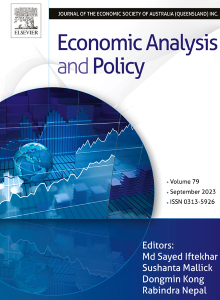通过政策协同促进绿色技术创新:来自低碳城市和创新型城市双试点政策的证据
IF 7.9
2区 经济学
Q1 ECONOMICS
引用次数: 0
摘要
绿色技术创新(GTI)是克服经济发展与环境保护之间两难困境的关键,需要整合环境监管政策和创新激励政策来抵消其双重外部性。本研究基于 2007 年至 2022 年中国 281 个地级市的面板数据,考察了低碳城市试点政策(LCCPP)和创新型城市试点政策(ICPP)双试点政策(DPP)对 GTI 的影响。我们发现,低碳城市试点政策对实质性绿色技术创新(SUGTI)和战略性绿色技术创新(STGTI)均有明显改善,其中对战略性绿色技术创新的影响更为明显。与 LCCPP 或 ICPP 的单一试点政策相比,LCCPP 和 ICPP 显示出政策协同效应和更持续、更强大的影响力。机制分析表明,DPP 通过提高创新补贴、自主创新能力和创新效率,纠正了创新知识的正外部性。DPP 还通过促进环境服务、产业转型和清洁生产来纠正环境污染的负外部性。在西部城市、产业集聚程度低的城市、资源丰富的城市和环境意识淡薄的城市,DPP 对 GTI 的影响并不明显。此外,DPP 对周边城市的 GTI 产生了示范效应。我们的研究结果表明,强化 LCCPP 和 ICPP 的政策协同效应可以更有效、更可持续地促进 SUGTI 和 STGTI。为了最大限度地发挥 LCCPP 和 ICPP 的协同效应,必须强化 LCCPP 的绿色效应和 ICPP 的创新效应,整合各种政策工具,使其相互补充、相互促进。本文章由计算机程序翻译,如有差异,请以英文原文为准。
Promoting green technology innovation through policy synergy: Evidence from the dual pilot policy of low-carbon city and innovative city
Green technology innovation (GTI) is the key to overcoming the dilemma between economic development and environmental protection, requiring integrates environmental regulatory policies and innovation incentive policies to counteract its double externalities. This study examined the effects of the dual pilot policy (DPP) of low-carbon city pilot policy (LCCPP) and innovative city pilot policy (ICPP) on GTI based on panel data from 281 prefecture-level cities in China spanning 2007 to 2022. We found that DPP significantly improves both substantive green technology innovation (SUGTI) and strategic green technology innovations (STGTI), with a more pronounced effect identified on STGTI. LCCPP and ICPP demonstrate a policy-synergistic effect and a more sustainable and powerful influence compared to the single pilot policy of LCCPP or ICPP. Mechanism analysis reveals that DPP corrects the positive externalities of innovative knowledge by improving innovation subsidies, independent innovation capabilities, and innovation efficiency. DPP also corrects the negative externalities of environmental pollution by promoting environmental services, industrial transformation, and cleaner production. This effect of DPP on GTI appears insignificant in western cities, cities with low industry agglomeration, cities with abundant resource, and cities with low environmental awareness. Moreover, DPP engenders a demonstration effect for neighboring cities in their GTI. Our findings reveal that intensifying the policy synergy effects of LCCPP and ICPP can more efficiently and sustainably promote SUGTI and STGTI. To maximize the synergistic effects of LCCPP and ICPP, it is essential to strength the green effect of LCCPP and the innovative effect of ICPP, integrating various policy tools to complement and reinforce each other.
求助全文
通过发布文献求助,成功后即可免费获取论文全文。
去求助
来源期刊

Economic Analysis and Policy
ECONOMICS-
CiteScore
9.80
自引率
9.20%
发文量
231
审稿时长
93 days
期刊介绍:
Economic Analysis and Policy (established 1970) publishes articles from all branches of economics with a particular focus on research, theoretical and applied, which has strong policy relevance. The journal also publishes survey articles and empirical replications on key policy issues. Authors are expected to highlight the main insights in a non-technical introduction and in the conclusion.
 求助内容:
求助内容: 应助结果提醒方式:
应助结果提醒方式:


